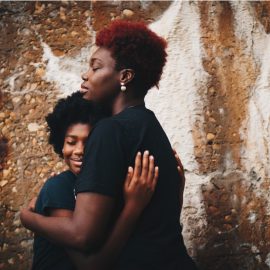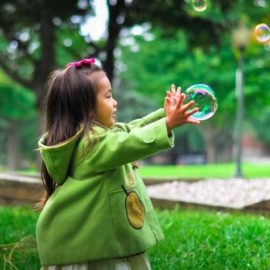

This article is an excerpt from the Shortform book guide to "The Gardener and the Carpenter" by Alison Gopnik. Shortform has the world's best summaries and analyses of books you should be reading.
Like this article? Sign up for a free trial here.
How do children learn by listening? What are the benefits of reading to your child?
Talking and reading to your child are proven methods for improving their skillsets in their developmental stages. Humans learn best through language, so it’s understandable that children’s development depends on oral teaching.
Find out how talking, listening, and reading are beneficial for your child, according to The Gardener and the Carpenter by Alison Gopnik.
Learning by Listening
While almost all animals learn through observation, Gopnik argues that humans are unique in their ability to learn by listening and through language. We can explain things to each other orally, and as we grow older we can recognize and decode signs and symbols in print to understand their meaning (in short, we can read). Because of this, talking and reading to children is hugely important to their development, and Gopnik notes it as one of the few genuinely effective ways caregivers should consciously teach children because it creates an environment that facilitates growth and learning.
However, making a deliberate plan about how you’ll use language to teach a child isn’t likely to have much effect because you can’t control how they process and interpret that information. You can only offer it to them so they can use it to grow, like plants in a garden.
| How Reading and Talking Help Your Child Gopnik doesn’t address the specific benefits of talking and reading to children, but research suggests that talking to children increases their language processing skills and ability to learn new words. Reading to children helps expose them to words and language they wouldn’t normally hear from parents and caregivers, further expanding their language capabilities. Additionally, parents can create the opportunity for a child to pick up language skills by fostering an environment in which kids feel included, like by talking to them face-to-face (which means joining them at their physical level), using gestures and vocal inflections, and encouraging them to respond once they’re old enough to do so (meaning a conversation is more beneficial than simply talking at children). |
Whose Testimony Do Children Believe?
Gopnik describes several studies that explore how young children assign credibility to testimony. Children are likely to believe what they’re told from a young age, but sometimes they’re told conflicting information by different people, and which person they trust often depends on their relationship with that person. It also depends on the quality of that relationship. Studies done on four year olds suggest that children often believe relatives like their mother over strangers, but this can vary depending on the type of attachment they have to their mother.
Attachment theory describes three types of attachment based on experiments that briefly separate infants from their mothers to see their reactions. Secure babies get upset in their mothers’ absence and are happy when she comes back. Avoidant babies behave as if they don’t care when their mother leaves or returns, but measuring their heart rates shows that they’re very upset. Anxious babies are upset when the mother leaves and continue to be upset when she returns. In cases where the mother and the stranger are equally likely to be correct, children with a secure attachment are more likely to believe their mother over a stranger, but children with an avoidant attachment are equally likely to believe their mother or a stranger.
Another experiment tested how much children believe answers that are likely to be wrong. Children were shown an image of a fish-bird hybrid that mostly looked like a bird. The mothers in the experiment called the animal a fish and the strangers called it a bird (which was more likely to be correct because it more closely resembled a bird). In cases where the stranger gives information that’s more likely to be correct, both secure and avoidant children were more likely to believe the stranger, but anxious children tended to believe their mother even when she was more likely to be wrong.
Children Pay Attention to Authority and Consensus
Children also pay attention to things like confidence and expertise, particularly as they grow older. At just three years old, children are more likely to believe people who speak confidently, and by five they can understand specialization of knowledge—they’re more likely to believe a doctor talking about medicine than to believe a layperson, for example.
(Shortform note: Confidence and expertise aren’t the only factors children take into account when deciding whether to believe someone’s testimony or not. Research also shows that children are more likely to believe someone who’s nice than someone who’s mean, even if the nice person has no expertise on the subject.)
They also tend to follow consensus and are more likely to believe something if a majority of people say it. They may also conform to a majority even when the majority is wrong. In studies done on children aged three to four, subjects were shown three lines and asked to pick the longest one. Kids would give a correct answer even if they saw an adult pick the wrong one, but if three adults picked the wrong one then about 25% of the children also picked the wrong one.
(Shortform note: This study was a variation of Solomon Asch’s conformity experiments. These experiments demonstrated that adults are also likely to conform to a group’s incorrect answers, possibly at an even higher rate than children: In a series of trials, close to 75% of adults in the study conformed to the group’s incorrect answers at least once. When asked why they gave answers they knew were wrong, many participants stated that they didn’t want to be ridiculed by other members of the group.)
Children Question Everything
Children also question constantly—as any parent can attest—and they’ll often continue to follow a line of questioning by asking for the reason behind each answer. Gopnik asserts that children don’t do this to be annoying or get attention: They genuinely want to know—specifically, they want to understand the causality of events, and each explanation helps them build their understanding of the world. While it may be frustrating at times, honestly and adequately answering children’s “why” questions helps them grow and learn.
(Shortform note: Psychologists say answering a child’s “why” questions validates their curiosity, which, as Gopnik states, helps them learn more. They also suggest that “why” questions give parents the chance to model decision-making skills and thought processes for their children to help them better understand how to solve problems and make good choices. However, some experts recommend encouraging children to ask “how” or “what” questions instead of “why” questions when speaking with their friends to avoid appearing judgmental.)

———End of Preview———
Like what you just read? Read the rest of the world's best book summary and analysis of Alison Gopnik's "The Gardener and the Carpenter" at Shortform.
Here's what you'll find in our full The Gardener and the Carpenter summary:
- The difference between gardner and carpenter parenting styles
- Why parenting should not be a form of work but an act of love
- How the schooling model fails to effectively support children’s learning






